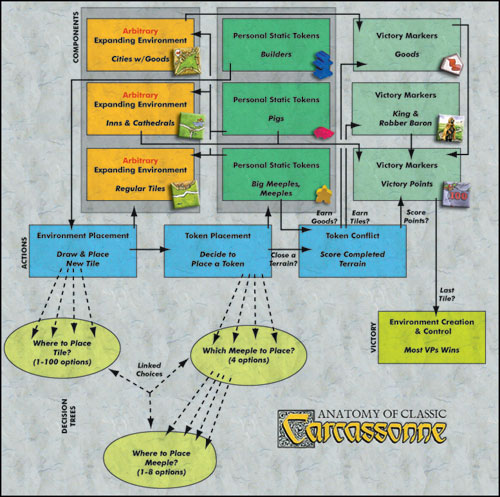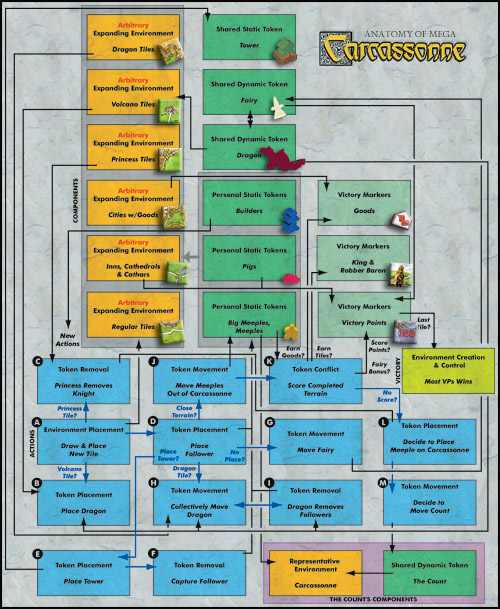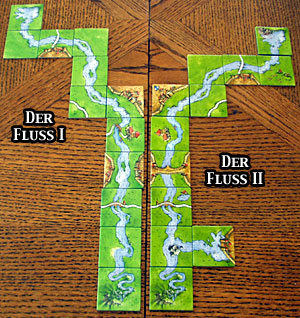 This is the fourth article in my series about Carcassonne. See part one for a discussion of the base game, part two for a discussion of tile distribution and balance in the expansions and part three for a discussion of cooperation, competition, and theming in the expansions.
This is the fourth article in my series about Carcassonne. See part one for a discussion of the base game, part two for a discussion of tile distribution and balance in the expansions and part three for a discussion of cooperation, competition, and theming in the expansions.There are many ways to expand a successful game system. Ticket to Ride continues to put out new editions of the game, featuring new maps and some new rules, an approach also seen in Empire Builder and other games.
Alhambra continues to publish small, distinct supplements which are easy to put in a game or take out because they form very different game elements.
The Settlers of Catan has tried both approaches, with standalone games like The Settlers of the Stone Age and also distinct add-ons like The Seafarers of Catan and The Cities & Knights of Catan. It's also offered semi-new games such as the Historical Scenarios, which are very similar to the standalone variants offered by other systems but reuse game components
Carcassonne, on the other hand, has centered its expansion policy on a different, and somewhat dubious method. Hans im Gluck just keeps on adding new tiles to the game, which once mixed in are somewhat difficult to pull out, unless you have tile distribution sheets showing you exactly what belongs and what doesn't. In certain ways, Carcassonne shows how not to expand a game. Because tiles can't be removed without work, the game keeps getting longer and longer and more and more complex.
This week I want to concentrate on that complexity, and to map out what the gameplay of the SdJ winner looks like, comparing the original game, the classic expansions, and the more recent brood.
Adding Difficulty to a Game
As I wrote in part 3 of this series, it was King & Scout which started to burn me out on the game's complexity. That one additional thing to keep track of--the special VP tiles for closing the biggest roads and cities--was the figurative straw that broke my Carcassonne's back. Granted those two little tiles really aren't that complex, but as one more thing they were too much. I never play with the King and Robber Baron tiles any more. Other peoples' tolerances will be different, but I suspect the number of people who can mindfully play a MegaCarcassonne game, with all 160+ tiles, is small.
Classic Carcassonne: I've spoken elsewhere about how I consider the classic Carcassonne set of Inns & Cathedrals, Traders & Builders, and King & Scout to be a fairly ideal playing environment. In the last couple of articles I outlined some of the reasons, such as the fact that these three expansions filled out the game's tile distribution, and that these three expansions were the ones that fit in most with the original game's mix of cooperation and competition.
 Diagraming out the expansion's anatomy, however, shows a surprising elegance to their overall structure, which may be another reason to like this particular set. The original Carcassonne game had a pure simplicity to it (as shown in the thumbnail, nearby). However the classic Carcassonne mixture maintains a surprising balance.
Diagraming out the expansion's anatomy, however, shows a surprising elegance to their overall structure, which may be another reason to like this particular set. The original Carcassonne game had a pure simplicity to it (as shown in the thumbnail, nearby). However the classic Carcassonne mixture maintains a surprising balance.- There remain just three core actions: environment placement, token placement, and token conflict.
- There are now three main decisions: where to place a tile, which token to place, and where to place that token.
- There are now three general types of tiles: regular tiles, inn & cathedral tiles which modify scoring, and goods tiles which influence closure.
- There are now three general types of meeples: regular meeples which influence token conflicts, pigs which modify scoring, and builders which allow extra actions.
- There are now three general types of scoring markers: regular victory points, king & robber baron VP tiles, and goods.
- There are now three possible results for closing a terrain: scoring points, earning VP tiles, and earning goods.
The result is a complex, but straightforward general gameplay model, as shown in the diagram below. Click for a larger, crisper view:

The Later Expansions: I'm sure there won't be much surprise when I again say that the later Carcassonne expansions moved things in some very different directions. As my final MegaCarcassonne diagram (below) shows, the game has gotten a lot more complex. My original Carcassonne gameplay diagram showed 7 distinct elements, and my classic Carcassonne diagram expanded that to 13. The later expansions increase that to 31. In other words, though the sizes of the classic Carcassonne and later Carcassonne sets are about the same, the later ones added about 3x as much complexity.
The biggest growth area is in gameplay "activity". Where before the expansions assiduously avoided changing Carcassonne's basic gameplay, starting with The Count of Carcassonne each new supplement adds a major new gameplay system. In Count it's the whole Carcassonne Count gameplay loop, in P&D it's the fairie-dragon loop, while in Tower it's the simpler Tower system.
I actually had a lot of trouble diagramming out the megaCarcassonne gameplay. Part of that was due to the restrictions of designing a diagram in a ratio that would be easily visible on the web, but part of it's because when you try and put the systems of all the later Carcassonne games together they form a spaghetti-like mess. Just trying to figure out the ordering of some of the interrelations, such as the ordering of the Princess knight-stealing and the dragon meeple-eating proved to be a challenge. I think the result is accurate but not necessarily obvious.
Althought some of the later expansion changes befuddle me (such as the tile distribution changes that I mentioned two articles ago), I have a theory as to why the complexity of Carcassonne started dramatically racheting up with Count; it also explains why the game suddenly became more competitive at that point. I'm guessing that by the time 2004 rolled around Hans im Gluck had sold most of what they were going to sell to the SdJ-worshipping general public, and so they explicitly decided to start pushing for the more serious gamers. And what do serious gamers want? Competition and complexity, the exact ingredients that a general audience would probably disprove of.
So that's my theory about the later Carcassonne expansions.
Here's my final anatomy diagram for Carcassonne, and the one that required the most time and hair-pulling of all of them. You're really going to need to click on this one to make out the details:

As I said, it's a spaghetti-like mess, and that was even after oversimplifying some of the component-action interrelations.
The Rivers
I've complained some about the recent evolution of Carcassonne, mostly because I don't like how much things changed after 2003. Carcassonne is no longer the game that I started playing, and competition and complexity aren't what I'm personally looking for if I sit down to play a Carcassonne game. (Instead I'm looking for a casual game to play with my wife or less gamerly friends, and if I want a more serious game, then I look elsewhere.) However I don't want to close this part of this series off with my whining. So, I'd like to talk about the recent release of River II. I think it shows not only how a supplement can be successfully remodeled, but also acts as a benchmark for the evolution of the game.
 The nearby picture, though not as elegant as Aldaron's distribution diagrams, shows the differences between the two rivers. What's most surprising, perhaps, is that they're pretty similar. A minimum of changes have been made to the River, but all the changes are good.
The nearby picture, though not as elegant as Aldaron's distribution diagrams, shows the differences between the two rivers. What's most surprising, perhaps, is that they're pretty similar. A minimum of changes have been made to the River, but all the changes are good.The biggest complaint about the original river was always that it created huge fields, especially at the two ends of the river. This new river still has some of that potential, but it decreases field size. Where the original river cut the board into 5 starting fields, the new one cuts it into 7.
It's worth briefly mentioning the other changes:
- The new River better integrates with all the major expansions, because there's one inn (from I&C), one pig field (harkening to T&B), and one volcano (from P&D). This is a purely aesthetic boon, but a nice one.
- The river adds a branch, and now you can build on either branch. This slightly increases the strategy of the river-building phase since you now have two places to build on for some of the time.
- A pennant on the one castle corner, combined with that aforementioned inn help increase the valuations of these initial terrains, making people more likely to place on them, and thus more likely to feel like they're making important decisions.
- The volcano insures that the dragon gets placed on the board before any dragon tiles could move it, thus short-circuiting an inelegant aspect of the Princess & the Dragon expansion.
Conclusion
I've spent a lot of time knocking the later expansions to Carcassonne throughout these articles, but I don't mean to suggest they're necessarily bad supplements. More correctly, they're different.
The classic Carcassonne supplements made certain decisions about balance (that all the terrain types should have somewhat comparable values), about tile distribution (that fields should be smaller and that stealing into someone's terrain should be a challenge), about competition (that it shouldn't be in your face), and about complexity (that it should be limited to new tiles and followers, not new action systems).
The later Carcassonne expansions have reversed almost all of these trends.
What I hope I've done in these three articles is to carefully denote (and graphically illustrate) how the game has changed over the last years, and to thus leave it open to any players to first see the interesting changes that have occurred, to second understand a bit more about some of the design decisions, and to third then go out and put together the exact Carcassonne that makes them happiest.
I'm not quite done with Carcassonne yet. Next I plan to look at the variant games that have been released over the last few years, to one more time examine what decisions have been made to slowly change the game system over a span of 6 years. However, while I wrote these first four articles all in one fell swoop (back in March, during a week that my wife was out of town), I haven't yet scribed the articles I'm planning on the variant games. So, I'm going to put them on hold for a bit, while I hopefully wait for The Discovery to enter mainstream distribution; when I have that in hand, I'll be back with some more discussions of Carcassonne, probably this summer and fall.
Coming up, I've got discussions of the Golden Age of Gaming and Italian Game Design planned. I'll see you back here to move into those topics in 7.
6 comments:
Outstanding article, and series! Your analyses, examples, diagrams, and logic have made this a most interesting reading experience.
Our family enjoys Carcassonne and Hunters & Gatherers, and we play them often. We use the first River, Traders & Builders, and Inns & Cathedrals every game, but not the King and Scout expansion. Because there are six of us who enjoy playing together, we borrow the gray meeples from Carcassone for Hunters & Gatherers (with the builder and pig meeples for river huts). We see almost no difference between a 5-player and a 6-player game of H&G. {We also have enjoyed adding some variant rules posted on BGG, using the Auroch tiles to modify some of the scoring).
I'm looking forward to your future articles about the related games, such as H&G. Additionally, I have read that some people like The Ark of the Covenant better than the original Carcassonne. I'll be interested in your views, since I've not played it.
In the meantime, bring on your other planned articles.......
I've also played H&G 6-player. It's pretty chaotic, but so are any of the Carcassonne games with that many. We use quarters for the extra huts.
I do generally like Ark better as an introductory game. It's a lot cleaner than Carcassonne.
Hi Shannon,
I got the Carcassonne Big Box and wanted to refer back to your excellent articles to figure out how best to use it. Alas, all the nice charts now seem to be broken links to erzo.org and a google for the article also points to erzo.org. Is there a chance to get the image links updated? (I checked on the Geek but they don't seem to be there?)
Not sure if this will reach you but thanks in advance if there's a way to get this back in 'print'.
Appreciately,
Al
I really appreciate the time you spent writing these four articles. They were very helpful. Thanks! What do you think of adding the Tower expansion to your magic mix of the original Carcassonne, traders and Builders, and King and Scout?
Wow, this series of articles is a really good read. Are there any plans to get them updated with the new stuff that has been put out in the recent years, perhaps as an addendum of some sort?
Follow the links from the most recent post http://boredgamegeeks.blogspot.com/
Gone Gaming moved to BoardgameNews as of 01-Jan-2008
Post a Comment